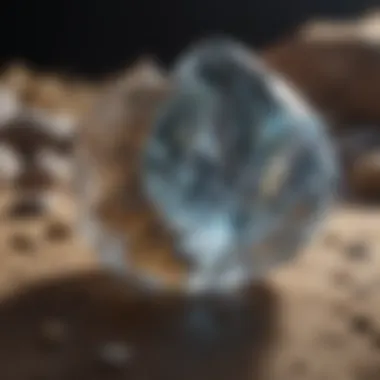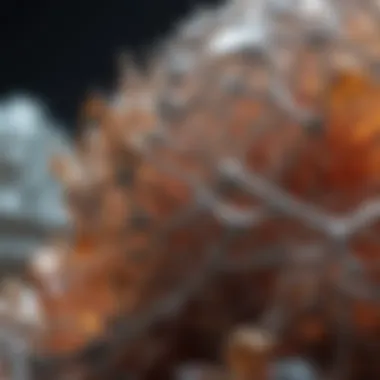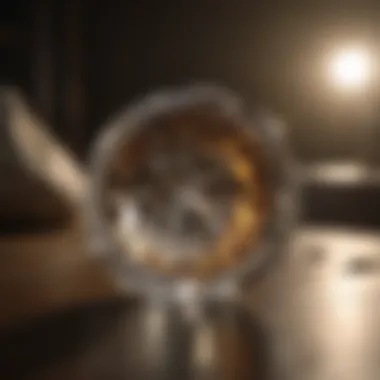Expert Guide on Identifying Genuine Crystals: Methods & Insights


Crystals hold a mesmerizing allure, but identifying real crystal can be a daunting task with a market flooded by imitations. Understanding the key characteristics of authentic crystals is crucial for collectors to make informed decisions and build a genuine collection. This comprehensive guide delves into the nuances of crystal identification, equipping enthusiasts with the knowledge needed to navigate the world of crystals with confidence.
Crystal Properties: Unveiling the Secrets
Before diving into identifying real crystals, it is essential to grasp the fundamental properties that set them apart. Genuine crystals possess unique structural formations that refract light in distinctive ways, creating mesmerizing patterns within their transparent depths. Furthermore, each crystal type exhibits specific color variations, cleavage properties, and hardness levels that serve as telltale signs of authenticity. Delving into these intrinsic characteristics lays the foundation for accurate identification and distinguishes real crystals from synthetic counterparts.
Practical Identification Techniques: Navigating the Realm of Authenticity
Armed with knowledge of crystal properties, collectors can now embark on practical identification techniques to discern genuine crystals from clever imitations. Visual inspections under natural light reveal internal flaws, inclusions, and growth patterns that are indicative of natural crystallization processes. Additionally, conducting density tests, examining refractive indices, and employing ultraviolet light can further validate the authenticity of a crystal. By honing these identification skills, collectors can confidently separate real crystals from synthetic replicas, enriching their collection with genuine specimens.
Synthesizing the Information: Empowering Crystal Enthusiasts
Introduction ##The realm of crystals has long captivated curious minds and fervent collectors, offering not just aesthetic appeal, but a glimpse into the Earth's geological history. In this comprehensive guide on identifying real crystals, we delve into the intricacies of crystal properties and elucidate foolproof methodologies for distinguishing genuine crystals from their mimicry. This topic transcends mere visual appeal or market value; it connects us with the profound natural forces shaping our planet. By diving into the nuances of crystal identification, enthusiasts and collectors can enrich their understanding, forging a deeper connection with these mesmerizing geological wonders. Join us on this journey of exploration and revelation, as we unravel the secrets that lie within the crystalline world.
Understanding Crystal Properties
Understanding crystal properties is a critical aspect when it comes to differentiating between real crystal and imitations. In this comprehensive guide, readers will delve into the intricate details of various features that define authentic crystals. By grasping the properties of crystals, enthusiasts can distinguish genuine specimens from counterfeit ones with precision and confidence. This section sheds light on the fundamental attributes that play a pivotal role in crystal identification.
Crystal Structure
Crystal structure refers to the arrangement of atoms and molecules within a crystal lattice, giving each type of crystal its unique internal framework. The lattice pattern affects the external shape and overall appearance of the crystal. Understanding crystal structure provides essential insights into the composition and stability of the crystal, enabling collectors to recognize patterns and formations indicative of authenticity. By examining the geometric configuration of a crystal, experts can discern between genuine crystals and synthetic replicas.
Optical Properties


The optical properties of a crystal encompass its interaction with light, including traits such as refractive index, birefringence, and dispersion. These properties determine how light passes through the crystal, influencing its brilliance, color play, and visual allure. By assessing the optical characteristics of a crystal, collectors can identify authentic gemstones, as imitations often lack the distinct light behavior exhibited by natural crystals. Examining how light interacts with the crystal's structure aids in verifying its authenticity and quality.
Physical Properties
Physical properties of crystals include factors such as hardness, cleavage, and specific gravity. These characteristics provide valuable information about the durability and composition of a crystal. By evaluating physical properties, collectors can assess the integrity and natural origin of a specimen. For instance, the hardness of a crystal can help distinguish between a genuine mineral and a simulated counterpart, as synthetic materials often lack the hardness of natural gemstones. Understanding the physical attributes of crystals is essential for accurate identification and authentication.
Factors Influencing Crystal Identification
Factors influencing crystal identification play a crucial role in distinguishing between real crystals and imitations. Understanding these factors is essential for rock and fossil collectors to make informed decisions while assessing the authenticity of crystals. Color, transparency, and luster are key elements that impact the identification process. Each factor provides unique insights into the composition and quality of the crystal, aiding collectors in differentiating genuine pieces from artificial ones. By examining these influencing factors closely, enthusiasts can develop a discerning eye for authentic crystals and avoid falling prey to counterfeits.
Color
Color serves as a significant factor in crystal identification due to its correlation with mineral composition. Different minerals exhibit distinctive colors based on their chemical makeup, allowing collectors to identify specific types of crystals. Variations in hue, intensity, and clarity of color provide valuable clues about the purity and authenticity of a crystal. Understanding the significance of color in relation to crystal formation and structure is vital for accurately determining the genuineness of a specimen.
Transparency
Transparency is another essential aspect that influences crystal identification. The degree of transparency in a crystal indicates its purity and internal structure. Authentic crystals often possess a high level of transparency, allowing light to pass through with minimal obstruction. By examining transparency levels, collectors can assess the quality of a crystal and differentiate it from synthetic or dyed counterparts. Understanding how transparency is affected by external factors such as fractures or inclusions is crucial for accurate identification.
Luster
Luster refers to the reflective quality of a crystal's surface, which plays a key role in determining its authenticity. The type of luster displayed by a crystal can indicate its mineral composition and crystal structure. Genuine crystals typically exhibit a natural, radiant luster that reflects light uniformly across the surface. Different luster types, such as metallic, vitreous, or pearly, provide valuable insights into the authenticity of a crystal. By evaluating the luster characteristics of a specimen, collectors can make informed judgments about its quality and genuineness.
Popular Crystal Types


Unlike in other sections, where we focus on understanding properties or testing methods, here we delve into the pivotal aspect of popular crystal types. This discussion is crucial as different crystals hold various significance and benefits. Identifying them and knowing their characteristics is essential for collectors to distinguish between the multitude available in the market realistically.
Quartz
Quartz, one of the most popular crystals, deserves special attention due to its widespread availability and versatility. From clear quartz to rose quartz, each variant possesses unique properties that make them desirable to collectors and enthusiasts alike. Understanding the nuances of quartz not only aids in differentiating it from other crystals but also in appreciating its aesthetic and metaphysical value.
Amethyst
Amethyst, with its distinct purple hue, stands out among crystal enthusiasts. This crystal, known for its calming and protective qualities, has captured the interest of many due to its physical beauty and reputed healing properties. Exploring the origins and characteristics of amethyst allows collectors to deepen their understanding of this cherished crystal and its potential benefits.
Citrine
Citrine, with its sunny and bright appearance, offers a unique contrast to other popular crystals. This crystal, associated with abundance and positivity, appeals to those seeking emotional balance and prosperity. Recognizing the features that define citrine sets it apart in the realm of crystals, providing collectors with a valuable addition to their collection.
Methods for Identifying Real Crystal
In the realm of crystal identification, the methodologies employed play a vital role in separating genuine crystals from counterfeits. This section delves deep into the processes and tests that can be utilized to determine the authenticity of crystals. By comprehensively explaining these methods, readers gain valuable insights into crystal authentication, enabling them to make informed decisions when assessing crystal specimens.
Scratch Test
A fundamental technique in crystal identification, the scratch test involves assessing the hardness of a crystal by scratching it against specified materials. This method, popularized by Friedrich Mohs with his Mohs Scale of Mineral Hardness, provides a standardized way to measure relative hardness. By conducting a scratch test, collectors and enthusiasts can determine the hardness of a crystal, aiding in narrowing down potential crystal identities and distinguishing between varying mineral species.
Density Test


Density serves as a critical property when identifying crystals. The density test involves measuring the mass of a crystal specimen and comparing it against its volume or size. By calculating the density of a crystal, one can glean valuable information about its composition and potentially differentiate between different crystal types with varying densities. This test is particularly helpful in verifying the authenticity of crystals, as imitations often exhibit discrepancies in density compared to genuine counterparts.
UV Light Test
The UV light test is a sophisticated method used to uncover unique luminescent properties exhibited by certain crystals under ultraviolet illumination. By subjecting crystal specimens to UV light, collectors can observe distinctive fluorescent or phosphorescent responses that are characteristic of specific minerals. This test serves as a powerful tool in crystal identification, as many crystals display distinct fluorescence patterns that can aid in confirming their authenticity. Understanding the UV light reactions of different crystals can significantly enhance the accuracy of crystal authentication processes.
Common Misconceptions about Crystal Identification
In the realm of crystal identification, it is essential to debunk common misconceptions that can often mislead enthusiasts and collectors. By addressing these erroneous beliefs head-on, individuals can hone their discernment skills and avoid falling prey to misinformation. One prevalent misconception pertains to the correlation between price and crystal authenticity. Contrary to popular belief, a high price tag does not always guarantee the genuineness of a crystal. While certain rare or large crystals may indeed command higher prices, authenticity cannot be solely determined by cost. Therefore, it is imperative for enthusiasts to look beyond the price tag and delve into other key indicators of authenticity.
Price (250-300 words)
The notion that price alone reflects the authenticity of a crystal is a common fallacy. Many believe that a higher price equates to a genuine crystal, while a lower price signifies a fake. However, this oversimplification overlooks the intricate factors influencing pricing within the crystal market. Various elements, such as scarcity, demand, size, quality, and market trends, play pivotal roles in determining the price of a crystal. In some cases, highly sought-after crystals may command exorbitant prices due to their rarity, aesthetics, or metaphysical properties. On the other hand, certain less popular or more abundant crystals may carry lower price tags despite their authenticity. Therefore, relying solely on price as an indicator of authenticity can be misleading and may result in overlooking genuine crystals that are reasonably priced.
Origin (250-300 words)
Another common misconception in crystal identification pertains to the significance of a crystal's origin. While the origin of a crystal can provide valuable insights into its geological formation and potential properties, it should not be the sole determinant of authenticity. Oftentimes, enthusiasts attribute superior quality or authenticity solely based on a crystal's origin, associating specific regions with genuine specimens. However, the global nature of the crystal industry means that authentic crystals can originate from various countries and geological sources. Genuine crystals can be found in diverse locations worldwide, each bearing unique characteristics influenced by their geological environment. Therefore, while considering a crystal's origin can be informative, it is essential to complement this factor with a comprehensive analysis of its properties and characteristics to confirm authenticity.
Complexity (250-300 words)
The complexity of crystal identification presents another prevalent misconception that can confound collectors. Some individuals perceive crystal identification as a highly intricate and esoteric process reserved for experts, reinforcing the belief that only seasoned professionals can accurately distinguish real crystals from imitations. This misconception often stems from the intricate terminology, specialised equipment, and scientific jargon associated with crystal analysis. However, with the right guidance and basic knowledge of crystal properties, enthusiasts can develop the skills necessary to identify authentic crystals with confidence. By elucidating the principles of crystal structure, optical properties, and practical identification methods, individuals can navigate the complexity of crystal identification successfully. Dispelling the myth of complexity surrounding crystal identification opens up this fascinating field to a broader audience, empowering enthusiasts to engage with crystals authentically and enrich their collecting experience.
Conclusion
In the realm of crystal identification, the conclusion serves as the culmination of a meticulous journey through the facets of crystal authenticity. As we dissected the various properties and tests to unveil the genuineness of crystals, it becomes abundantly clear that this subject is not merely about adornment but delves deep into the realms of geology and mineralogy. Understanding the importance of the conclusion is paramount in deciphering the true worth of crystals that adorn collectors' shelves.
The conclusion acts as the reckoning point, where the pieces of the crystal puzzle fit snugly into place. By unraveling the complexities surrounding crystal identification, we arm ourselves with knowledge that goes beyond mere visual allure. Recognizing that price, origin, or perceived complexity can often mask the real authenticity of a crystal, we equip ourselves with the tools to discern fact from fiction in the kingdom of gemstones and minerals.
Delving into the depths of identifying real crystals unveils a world where precision and keen observation reign supreme. It is not merely about owning a sparkling gem but about understanding the geological forces that shaped it over millennia. The conclusion, therefore, is not just a summing up of facts but a gateway to a deeper appreciation for the Earth's hidden treasures that lie beneath the surface, awaiting discovery by those curious and discerning enough to seek them out.







